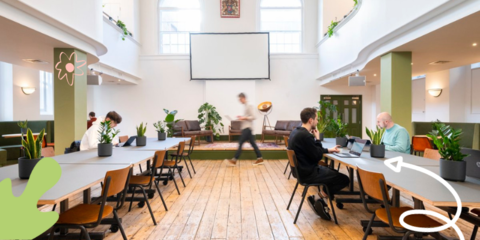Virtual coworking: your gateway into deep work

By Micah Yongo
•
Apr 11, 2024
The landscape of work has shifted considerably in recent years. With many professionals stepping away from exhausting commutes and office environments in favor of the flexibility that comes with remote work.
As coworking options boom in the aftermath, an important practice is quickly gaining traction among busy freelancers and entrepreneurs and reshaping work paradigms: virtual coworking.
Let’s take a look at all there is to know about virtual coworking. What it is, the benefits, and the best tools and tips for making it an effective part of your workday.
Keep reading to learn more about the ins and outs of virtual coworking or skip down to FLOWN’s tips on:
What is virtual coworking?
At its core, virtual coworking is the simple practice of working on tasks in the presence of others via video call. You simply hop on a call, share your goals with fellow remote workers, and dive into your work.
It’s a lot like the boost in motivation you might feel when working next to someone who keeps you accountable, or within the focused environment of a library or shared workspace.
Unlike traditional coworking spaces or in-person accountability buddies, you don’t need to worry about matching schedules or commuting. Virtual coworking offers the convenience of joining a supportive online community of co-workers from any location, at any time.
Sure, sounds odd, but it's effective. Being in the company of others, even virtually, who are engaged in their tasks activates a number of psychological triggers that enhance your ability to concentrate, commit to your work, and accomplish your goals.
With there being evidence to suggest that the average desk worker loses 2 hours a day to distractions and interruptions, virtual coworking offers a powerful tool for remote working professionals keen to optimize their time and boost their productivity.
Try a virtual coworking session
Virtual coworking sessions are designed to free you from distraction and take the willpower out of productivity.
Try virtual coworking with FLOWN for FREE today.
Get a 30-day trial, no credit card details required, with unlimited virtual coworking sessions, and see how much you can tick off your to-do list!
Who uses virtual coworking?
The beauty of virtual coworking lies in its universal appeal. Anyone can do it, and it works for almost any task — work tasks, tidying, hobbies, whatever.
That said, virtual coworking is especially popular among remote workers or students in search of structure, individuals with ADHD, and creatives or academics in need of community.
The silent camaraderie of virtual coworking helps to anchor your attention to your work so that you can focus more deeply, whatever that work might be.
Virtual coworking for students
For busy students and academics, finding a way to focus and complete important work can be especially challenging. And with the rise in remote learning, challenges around motivation, attainment and wellbeing are growing steeper.
Research shows:
Student burnout is becoming an increasing problem
University drop out rates have been drastically increasing since 2021
Virtual coworking offers students a way to overcome procrastination, lessen the burden of study tasks, and get through their coursework and revision with greater ease.
With evidence to suggest virtual coworking can improve wellbeing, it offers the ideal solution for students and academics dealing with the pressures of exams and tenure-related deadlines.
Virtual coworking for remote workers
One of the most common challenges of working remotely is managing the blurring lines between personal and professional life. Research shows that when domestic chores and work tasks are happening within the same physical space it can be difficult to ‘switch off’ from work at the end of the workday.
In a study from Forbes 69% of remote workers reported increased challenges with burnout from digital communication tools.
Meanwhile, a 2 year study by Stanford revealed that over half of WFH employees work more hours now than when they were in the office.
Against this backdrop, finding practical ways to keep your professional and personal life separate can be vital.
The structure of virtual coworking helps to address this problem in a few ways:
Virtual coworking sessions often have a defined start and finish time. This allows individuals to use timeblocking to schedule their work tasks and safeguard against overwork.
Virtual coworking sessions help you to set realistic goals. This allows you to manage time more effectively and mitigate against the natural tendency, known as Hofstadter's Law, to overestimate what can be achieved within a given time period.
Virtual coworking can help to prevent context switching. By setting a single task or goal for the session, you’re less likely to fall prey to the negative effects of multitasking which can lead to overwhelm.
Virtual coworking makes it easier to make progress with tasks. The momentum of getting things done offers a motivational feedback loop that allows the experience of work to feel more positive.
Virtual coworking for entrepreneurs
For many entrepreneurs, hopping from client meetings to focused desk work to presentations is a normal feature of their day. But this constant context switching often comes at a price.
Whenever our brains are required to quickly shift attention between different types of tasks, it can result in what’s known as ‘attention residue’; it’s like a mini-hangover your brain experiences whenever your concentration is interrupted or forced to move between tasks.
Attention residue can:
Impair productivity
Erode memory
Increase stress
Lead to inattentional blindness, causing you to miss details in plain sight and make uncharacteristic mistakes.
Not a good recipe for running a business.
Virtual coworking can minimize these effects by helping you fully immerse yourself in a task, and properly shut down once you’re finished.
This provides a mental buffer that enables entrepreneurs to move between tasks more smoothly, structure their time, and keep their minds fresh.
Virtual coworking for people with ADHD
People who have or suspect they have ADHD may find virtual coworking especially impactful.
Unlike many ADHD tools, virtual coworking is not another productivity strategy, learning resource or version of a to-do list. It is a tool that can be used while you work to enhance focus, structure the day, and get important work done.
This is because virtual coworking taps into the practice of body doubling, a technique familiar among ADHD coaches, and often used to help those with ADHD stay on task.
By offering an online version of this practice, those with ADHD are able to reap the benefits more readily and cut out the typical barriers to physical body doubling such as travel and scheduling.
All of the upside, none of the headaches.
Discover how to manage your
ADHD at work
Check out our comprehensive guide for resources, tools and support with ADHD in the workplace.

Why do people choose virtual coworking?
Virtual coworking community: find your tribe with virtual coworking
Working remotely can feel just that — remote. A report by Buffer highlighted loneliness as the second-most reported challenge amongst remote workers, coming right after collaboration and communication.
Although evidence suggests that working away from an office is more productive, the feeling of isolation common among many remote working professionals can undermine wellbeing.
Virtual coworking helps to combat this trend by offering a sense of structure and connectedness with others, all while eliminating the need for a daily commute.
This sense of community, where support and encouragement are not bound by geography, enables individuals to find new connections and thrive alongside others within their chosen fields.
Transform your work life with virtual coworking
Writer and content strategist Jo Gifford shares her experience on the incredible perks of virtual coworking

Virtual coworking platforms: tools to succeed
A key aspect of virtual coworking is the tools that make it happen. Although every virtual coworking platform has its unique flavor, most involve an online space where individuals join via video call to work alongside one another on-camera.
Being on-camera while you work taps into a psychological phenomenon known as the Hawthorne Effect, where the feeling of being watched helps to keep you accountable to working on your task.
What is the Hawthorne Effect?
Some platforms utilize trained in-house coaches to facilitate virtual coworking sessions and achieve this effect. Others opt for a more user-led approach.
FLOWN facilitates both of these virtual coworking styles, along with enabling members to design and set up sessions of their own they can then invite others to join.
Across each of these formats, the impact of working or hobbying in a shared digital space is what helps people to focus and lends virtual coworking its appeal.
How virtual coworking sessions maximize productivity
While physical coworking spaces tend to facilitate networking and the building of professional connections, virtual coworking spaces are more focused on:
Helping individuals to complete tasks
Boosting individuals productivity
Optimizing time management
Because of this, some facilitated formats encourage accountability practices like intention setting. In these sessions, participants share their goals at the start and celebrate one another’s progress at the end.
Along with offering a chance to celebrate and be celebrated, practices like this are shown to offer a psychological trigger that can boost your output by doubling the chances of following through on the aims you’ve shared.
Virtual coworking accountability
One of the cornerstone benefits of virtual coworking is the accountability it fosters. This is to do with the positive social pressure that’s experienced when our actions are answerable to peers.
This sense of mutual support, where commitment to others enhances your commitment to yourself and your tasks, helps to remove the isolation of working remotely and increases the motivation to get things done.
Discover Fleets: group coaching and accountability that delivers results
Join a select group and expert guide for 6 weeks of group coaching to skyrocket your projects to new heights.
Whether you’re a writer, academic, entrepreneur or just want to unlock your productivity there’s a Fleet to suit your needs.
What is virtual coworking software?
Virtual coworking started out with video calling clients like Zoom and Skype, where individuals could arrange to gather online in groups to work together.
However, as the shift toward virtual coworking continues, people who often work at home are increasingly seeking more sophisticated ways to:
Connect with compatible accountability partners
Find community
Schedule virtual coworking sessions with minimal fuss.
Calling friends, collaborators or colleagues to arrange a suitable time to co-work can become a time and energy drain. It can also disrupt your workday if plans change for those you’d scheduled to work with.
Virtual coworking platforms offer an easy way for remote workers to join, schedule and create virtual coworking sessions with like-minded people all over the world.
With a global community of accountability buddies at the ready, busy professionals can easily structure their workday, find community, and block the time they need to complete their work with no more than a few clicks.
Although everyone will have different needs and priorities when it comes to choosing their ideal virtual coworking software, most platforms offer users a bevvy of virtual coworking sessions to book into or join.
This makes it easy for individuals to ensure they spend time working on important tasks rather than trying to align schedules.
Check out our guide to choosing
a virtual coworking app
Virtual coworking 101: FLOWN vs Caveday vs Flow Club vs Focusmate

Is virtual coworking free?
While most virtual coworking platforms offer free access to basic features, premium services are available for those seeking enhanced features. This can range from additional session types like breathwork and meditation, to access to 1-1 productivity coaching, workshops or the full library of available coworking sessions.
FLOWN offers free virtual coworking for 30 days with a no-strings-attached trial.
Although gathering online via any free video calling tool remains an option, many remote working employees and entrepreneurs are benefitting from the facilitated structure and tools found with virtual coworking platforms.
How to start virtual coworking?
Embarking on your virtual coworking journey begins with selecting the best platform for your needs.
Do you want professionally facilitated virtual coworking sessions, or sessions led by members within the platform’s community? Do you prefer to join group sessions, or be randomly connected with someone for 1-1 focus stints?
Factors like these, along with cost, community features, personal development opportunities or even your connection with the given platform’s brand are all worth considering before taking the plunge into virtual coworking.
In the end, much like a physical coworking space, it’s about finding where you feel most inspired to work alongside others.
How do I host a virtual coworking session?
In some ways, all you need to host a virtual coworking session is a strong WiFi connection, a video calling app, and some people.
However, in reality, hosting a good virtual coworking session involves more than just technical setup; it's about creating an atmosphere conducive to productivity and connection.
Although you don't need any prior experience facilitating or hosting virtual spaces, it can be helpful to take note from others who’ve done it well to observe how to interact, moderate and engage with participants.
Key tips for how to host and facilitate a virtual coworking session effectively could include the following:
Set clear objectives for the session
When hosting a virtual coworking session it can be helpful to clearly set expectations.
What kind of tasks should participants be working on alongside one another? How long will they be working on them? What behaviors will be expected of them at the start or end? Will they go into breakout rooms? How should they interact with one another there?
Providing as much clarity and guidance as possible can go a long way towards helping participants feel comfortable during the session.
Facilitate introductions among participants
Whereas some people are social butterflies, others are shrinking violets. Introducing a structure that can allow everyone to feel comfortable will help to ensure they get as much value as possible from the session.
Offering icebreakers and tightly defined time limits for participants to connect can help to evoke a sense of community and belonging, without disrupting everyone’s reason for being there — to get work done.
Strike a balance between work focus and social interaction
The dopamine hit we get from a positive social interaction can be an important benefit. Dopamine is associated with some key factors for being productive — motivation, concentration, creativity etc.
This means helping participants to enjoy one another’s company can actually help them to work more effectively during a virtual coworking session.
Think intentionally about steering interactions between participants that are positive, inclusive and limited.
Virtual coworking and the future of work
Remote working is far from new. The knowledge-driven economies of the Nordic countries and Silicon Valley have been reshaping our paradigms for where and how we can work as far back as the early 2000s.
With technology to support sustainable ways of working remotely, virtual coworking has become more than a trend; it’s the future of working together while apart and addresses the modern workforce's needs for flexibility, autonomy, and community.
Whether you’re a freelancer, a remote employee, someone with ADHD, or a student, virtual coworking offers a way to break free from the isolation of being office-free, and is emerging as the ultimate tool to allow modern professionals to build the work lives they’ve always dreamed of.

















